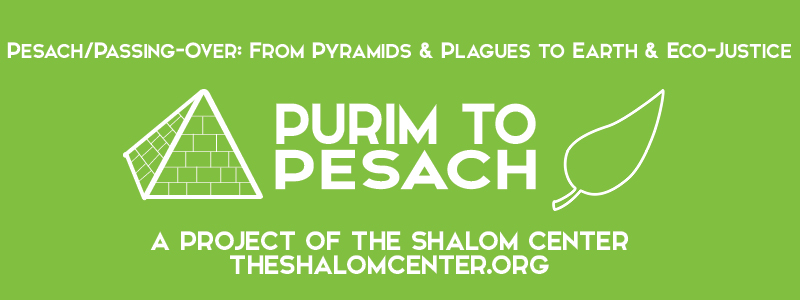Burnt Eggs & Tisha B'Av
Shemot 2: 23-24 ...and the children of
I raise the burnt egg of the seder plate. Inside a cry lies dormant; a cry that contains all cries. The Rabbis teach us not to avoid this cry. Further, they say, trust, feel, open, speak; know that these cries will not lead to annihilation, but to regeneration and redemption.
Yet, this wisdom is so hard to trust. Have we not been trained since childhood to avoid pain, to avoid tears? I have. All year our family ate a steady diet of American hope and optimism, wonders and miracles, in the form of Wonder Bread and Miracle Whip mayonnaise. Our childhood seder was no different, under guidance from the house of Reb Maxwell, we had no burnt egg at all. Instead, we had a pre-peeled, gleaming and tasty hard-boiled egg on our seder plate, laden with birth and spring joy.
It wasn’t until I was a college student studying in a Jerusalem Yeshiva that I saw a grown man cry. It was Tisha B’Av and the heat of the summer was intense. We first ate hard-boiled egg dipped into ashes, and then we sat on the ground and began prayers that included mournfully chanted lamentations. These laments of the persecuted and starving community in ancient
I couldn’t breathe, I was overwhelmed. I was sitting inside the day of the burnt egg. A day of many tragedies including the destruction of both ancient temples, the destruction of the city Betar, many medieval anti-semitic persecutions and even the Shoah, the Holocaust, are all folded into Tisha B’Av.
The burnt egg of Pesach is deepened by Tisha B’av. Tisha B’Av invites us to understand that no matter how much we do, hunger, hatred, greed, murder and malice will continue throughout the world. No matter how much we organize, the atmosphere will continue to heat. No matter how much we protest, species will stop being; the ending of birth; the death to all that could have been. Burnt eggs all. Can we sit still long enough and allow ourselves to grock this immense, on-going pain? Can we feel the sadness as it fills us? To hear the Earth cry? To weep with the Holy One?
This is so hard. Inner voices from childhood, from past generations, caution against crying. They warn of the attack that comes with vulnerability, they fear annihilation and the WAIL transforms into enemy. The burnt egg transforms into searing flame, burning all who come near. All the while, we become hypervigilant; choosing to live inside a lookout tower, dedicating ourselves to plugging leaks, plastering over, preventing disturbance. Or perhaps, we just skip merrily towards utopic redemption; forever choosing Disney’s ‘happily ever after’, over the pain and realism of Kafka.
The Rabbis offer us a helping hand, a contradiction to the path of avoidance and numbness. They know, from Shemot 2 found above, that redemption is activated by crying out; our very tears and groans are able to wake up this world; wake up ourselves. Rabbi Kalonymous Kalman Shapiro, the Rebbe of the Warsaw Ghetto (the anniversary of which is also tonight), taught from experience that avoiding the pain of our lives and the pain of the world, while seeming smart, only brings a numbness and silence that threatens both our very being and the Source of Life which animates the world. His teachings, from that ‘Time of Wrath’, testify that through our painful depths we also connect with the pain of the world and the Source of Life itself.
In the ritualized poetry of Tisha B’Av, the Mashiach is born only on the afternoon of Tisha B’Av after lamentations. In the words of the Safed Kabbalist Moshe Cordovero, with breaking, comes hope. Our Rabbis know that if we skip lamentations, we are in trouble. If we succumb and silently accept the misery and pain of our life without complaint, be it the slavery in Egypt or living blithely through mass extinctions, poisonous products and heating climate, then we are surely lost. Lost in numbing distractions, cynical, powerless anger or the constant busyness and distraction that is
So the burnt egg is kept on the seder plate. Allowing us to connect ancient temple sacrifice with the temple that is our body; the temple that is our earth; and the temple that is our home. Containing every ash laden egg, midnight lament, unpatched wall and heart-felt cry that is uttered. Reminding us to trust, feel, open and speak.
Please do not think I am mistaking the burnt egg for all of Pesach or replacing Tisha B’Av for Pesach. I am not; our story is only beginning. We also have karpas, green leafy hopeful karpas, the authentic spring joy of the seder plate. Our story is guiding us, encouraging us to not sidestep, sugar-coat or harden our hearts with indifference; to not turn away from places of pain and catastrophe. We are also being blessed with vision of new growth formed by the powers of regeneration that are continually flowing through our world. This inherent wisdom is waiting inside our story of wholeness, waiting to be retold and refreshed, again and again. We step inside the spiral again this year, knowing that redemption is not a ‘once and for all time’ event. After all, we are only human.




















